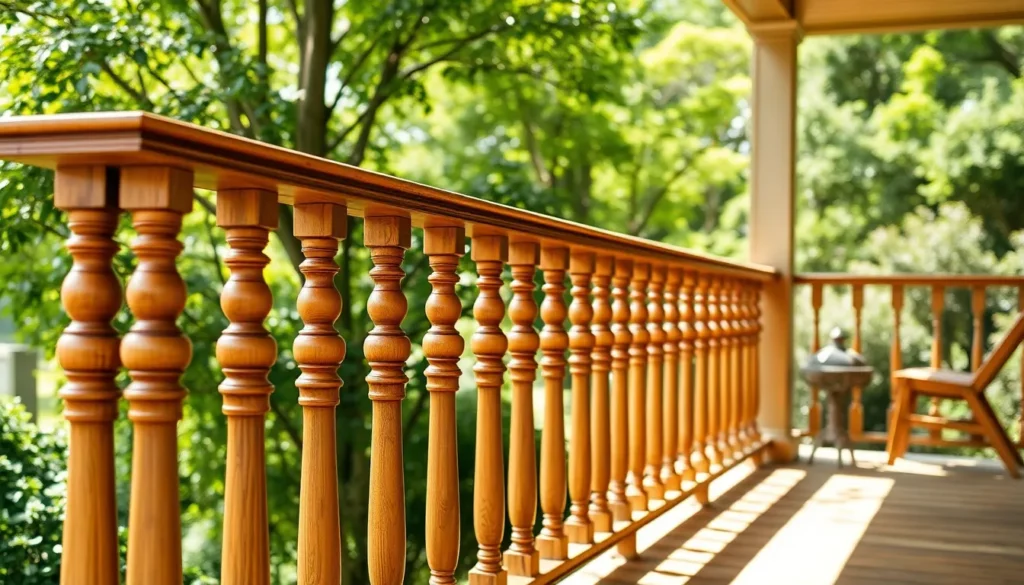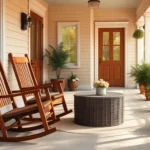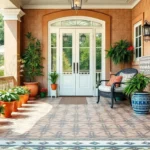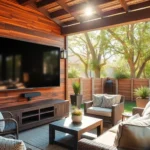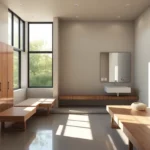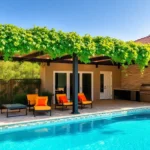We’ve all stood on a beautiful porch and admired how the perfect railing transforms the entire space from ordinary to extraordinary. Wood porch railings aren’t just safety features – they’re design statements that can dramatically boost your home’s curb appeal and value while creating that welcoming atmosphere we all crave.
Whether you’re building a new porch or updating an existing one the right wood railing design can make all the difference. From classic traditional styles that never go out of fashion to modern minimalist approaches that create clean lines we’ll explore options that work with every architectural style and budget.
Choosing the perfect wood railing involves more than just picking a pretty design. We need to consider durability weather resistance maintenance requirements and how the style complements our home’s existing features. Let’s jump into the most stunning and practical wood porch railing ideas that’ll have your neighbors asking for your designer’s number.
Classic Turned Wood Spindle Railings
Classic turned wood spindle railings remain the gold standard for traditional porch design. These timeless features combine safety with sophisticated craftsmanship that elevates any home’s architectural appeal.
Traditional Victorian Style Spindles
Victorian style spindles showcase intricate lathe work that transforms ordinary railings into decorative masterpieces. We see these ornate designs featuring multiple curves, bulbous sections, and detailed turning patterns that create visual interest from every angle. Traditional Victorian spindles typically measure 2 inches in diameter and incorporate three to five distinct turned elements per spindle.
Popular Victorian spindle patterns include the urn shape with flared tops and bottoms, the bottle design with narrow necks and wide bodies, and the double bulb style featuring two rounded sections. These decorative elements work exceptionally well on wraparound porches where their repetitive patterns create rhythm and movement across long stretches of railing.
Craftsmen originally turned these spindles from premium hardwoods like oak, maple, and cherry that could withstand detailed shaping without splitting. Today’s Victorian style spindles maintain those same quality standards while offering modern weather resistant finishes that protect the intricate details from moisture damage.
Simple Round Spindle Designs
Simple round spindle designs offer clean lines that complement both traditional and contemporary home styles. We recommend these streamlined options for homeowners seeking classic appeal without ornate detailing. Round spindles typically range from 1.5 to 2 inches in diameter and feature subtle curves that add visual softness without overwhelming the overall design.
Basic round spindles work particularly well on Colonial, Craftsman, and farmhouse style homes where simplicity enhances architectural authenticity. These designs cost significantly less than elaborate Victorian patterns while still providing the handcrafted appearance that distinguishes wood railings from manufactured alternatives.
Installation becomes more straightforward with simple round spindles since they require fewer precise measurements and alignment considerations. Most round spindle designs feature gentle tapers at both ends that create smooth transitions between the top and bottom rails.
Square Spindle Variations
Square spindle variations provide contemporary alternatives that maintain traditional wood railing appeal. We favor these geometric designs for their clean edges and modern aesthetic that suits updated traditional homes and transitional architecture styles. Square spindles typically measure 1.5 inches per side and can incorporate chamfered edges or decorative routing for added visual interest.
Craftsmen can create square spindles with twisted patterns that add texture while maintaining the geometric form. These twisted square designs bridge the gap between simple square profiles and more ornate turned options. The four flat surfaces of square spindles also accept stain and paint more evenly than rounded alternatives.
Square spindle installations offer practical advantages including easier spacing calculations and more secure connections at the top and bottom rails. The flat surfaces provide larger contact areas for screws and adhesives that create stronger joints than rounded spindles typically achieve.
Horizontal Slat Wood Railing Systems
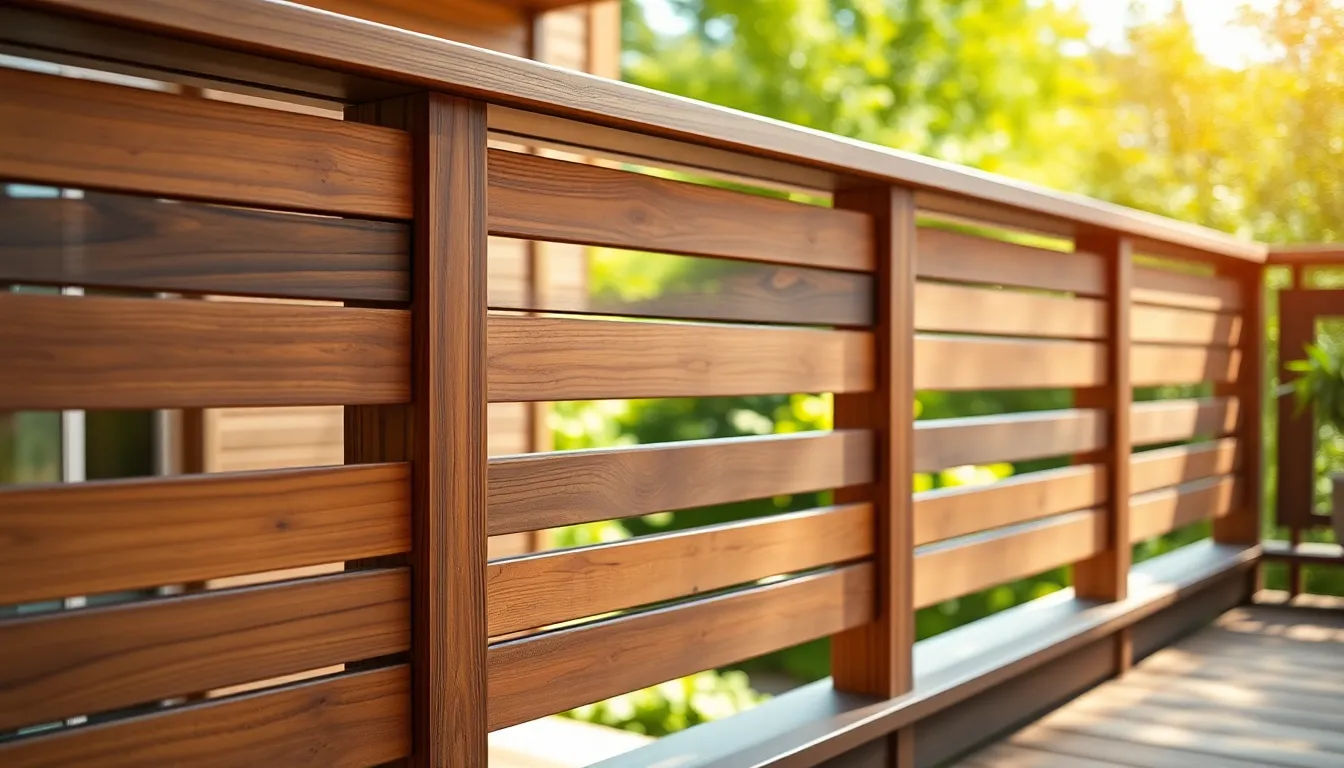
Moving beyond traditional spindle designs, horizontal wood slat railings bring a contemporary edge to porch construction while maintaining natural warmth. These systems feature wooden boards arranged horizontally between posts, creating clean lines that complement both rustic and modern architectural styles.
Modern Horizontal Board Designs
Modern horizontal designs emphasize minimalism through simple board arrangements and clean geometric lines. We’ve seen steel or metal rods integrated horizontally with wood elements to create balanced aesthetics that enhance durability. This combination delivers stylish functionality that works beautifully on any porch or deck area while maintaining open views of surrounding landscapes. Contemporary designs prioritize compliance with building codes about spacing requirements without compromising the sleek visual appeal.
Spaced Horizontal Slat Patterns
Spacing between horizontal slats creates openness while allowing natural light and airflow to pass through the railing system. Consistent gaps of approximately 2.5 inches or more provide visual breathing room while adhering to safety codes that require spaces smaller than a 4 inch sphere. Glass panels combined with horizontal wooden boards create unique viewing opportunities of surrounding landscapes while maintaining both safety standards and stylish design elements. Strategic spacing patterns enhance the overall aesthetic while ensuring proper ventilation around your porch area.
Mixed Width Horizontal Elements
Varying the width of horizontal slats adds compelling visual texture and breaks up monotonous design patterns. We recommend alternating wide and narrow boards to create ever-changing layering that blends rustic charm with modern sophistication. Picture frame style boxed cedar sections paired with horizontal metal pipes create pleasing contrast and design complexity without overwhelming the overall aesthetic. This approach allows for extensive customization opportunities, enabling homeowners to personalize their porch railings while maintaining structural integrity and visual balance.
Rustic Log and Branch Railing Ideas
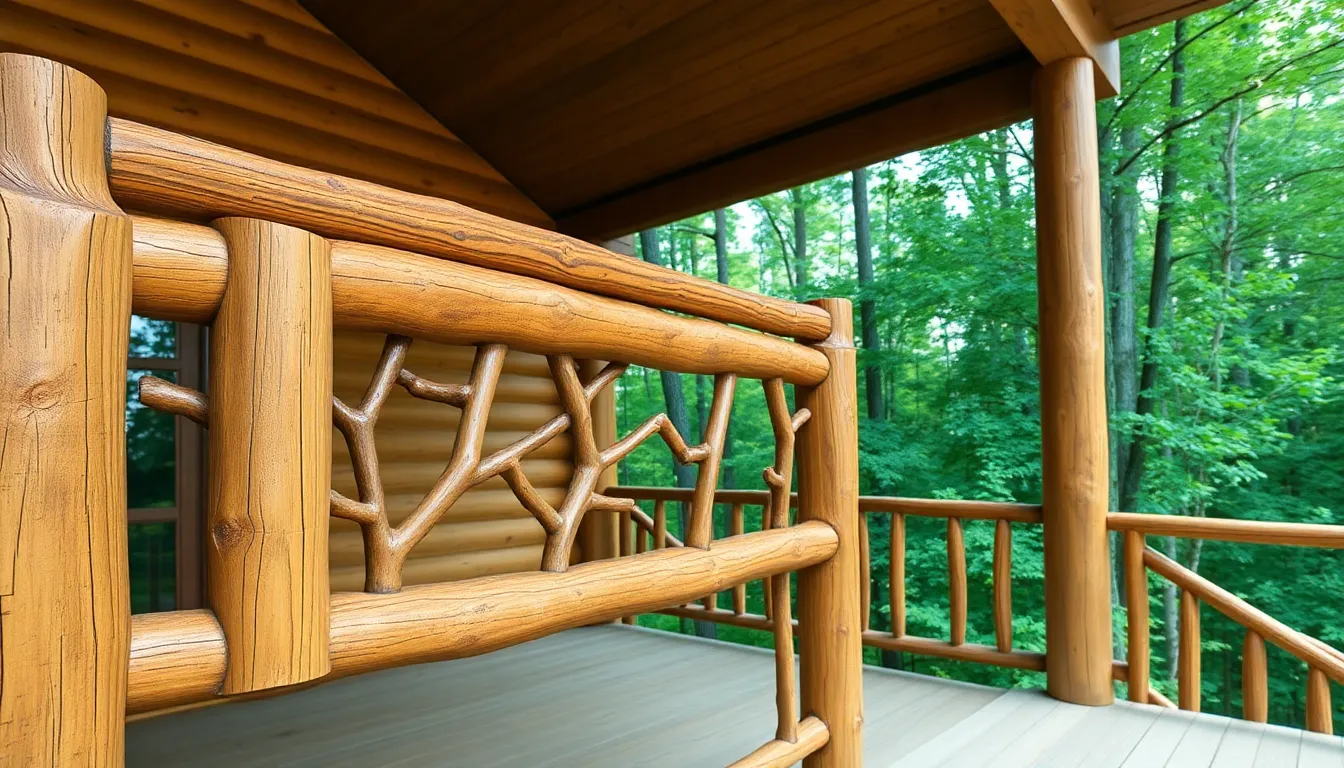
Moving from sleek horizontal designs to nature inspired styles, we explore rustic log and branch railings that bring raw woodland beauty to your porch. These handcrafted railings use unfinished materials like whole logs and natural branches to create an organic, cottage style aesthetic.
Natural Cedar Log Railings
Cedar stands out as our top choice for rustic log railings due to its exceptional resistance to decay and insects. This naturally durable wood maintains a warm, honey colored tone that develops rich character as it ages gracefully over time. We recommend using whole logs that are hand sanded but kept deliberately rough to showcase the wood’s authentic grain patterns and natural imperfections.
Posts crafted from cedar logs create sturdy anchor points, while matching top rails complete the rustic framework. Many homeowners choose to leave bark sections intact for extra visual texture, though peeled logs offer a cleaner appearance. Cedar’s inherent weather resistance means these railings require minimal maintenance while providing long lasting outdoor performance.
The natural oils in cedar wood repel moisture and insects without chemical treatments, making it an eco friendly option. We’ve found that cedar log railings pair beautifully with stone foundations and wood shake siding, creating cohesive rustic charm.
Decorative Branch Infill Patterns
Branch infills transform ordinary railing spaces into functional art pieces using carefully selected natural branches instead of traditional vertical balusters. We weave these branches between posts and top rails to create stunning patterns that preserve outdoor views while adding unique character. Popular designs include simple crisscross arrangements, intricate basket weave patterns, and abstract layouts that mimic natural vine growth.
Selecting branches requires attention to their natural curves and interesting shapes, as these elements become the focal points of your design. We recommend using branches from birch, willow, or dogwood trees for their flexibility and attractive bark patterns. Each branch arrangement becomes completely unique, ensuring your porch railing stands apart from standard designs.
Installation involves securing branches at multiple contact points to create stable, code compliant barriers. The artistic nature of branch infills allows for creative expression while maintaining safety requirements. These decorative patterns work exceptionally well on cabin porches, cottage style homes, and rustic retreat properties.
Rough Hewn Timber Designs
Rough hewn timber railings showcase thick, robust beams that appear hand cut with visible tool marks preserving old industry craftsmanship appeal. We deliberately avoid smooth finishes on these designs, instead celebrating the textured surfaces that highlight natural wood grain and authentic imperfections. The substantial beam dimensions emphasize strength and rustic character.
Traditional adze marks, saw cuts, and chisel impressions remain visible on the timber surfaces, telling the story of handcrafted construction. We typically use beams measuring 4×4 inches or larger to achieve the substantial appearance that defines this style. The weathered, aged look develops naturally over time, improving the authentic rustic appeal.
These timber designs pair exceptionally well with stone foundation elements and reclaimed wood porch flooring for complete design cohesion. The thick posts and rails create bold visual statements that complement log cabin architecture, farmhouse styles, and mountain retreat homes. Installation requires proper structural support due to the substantial weight of thick timber components.
Lattice and Trellis Wood Porch Railings
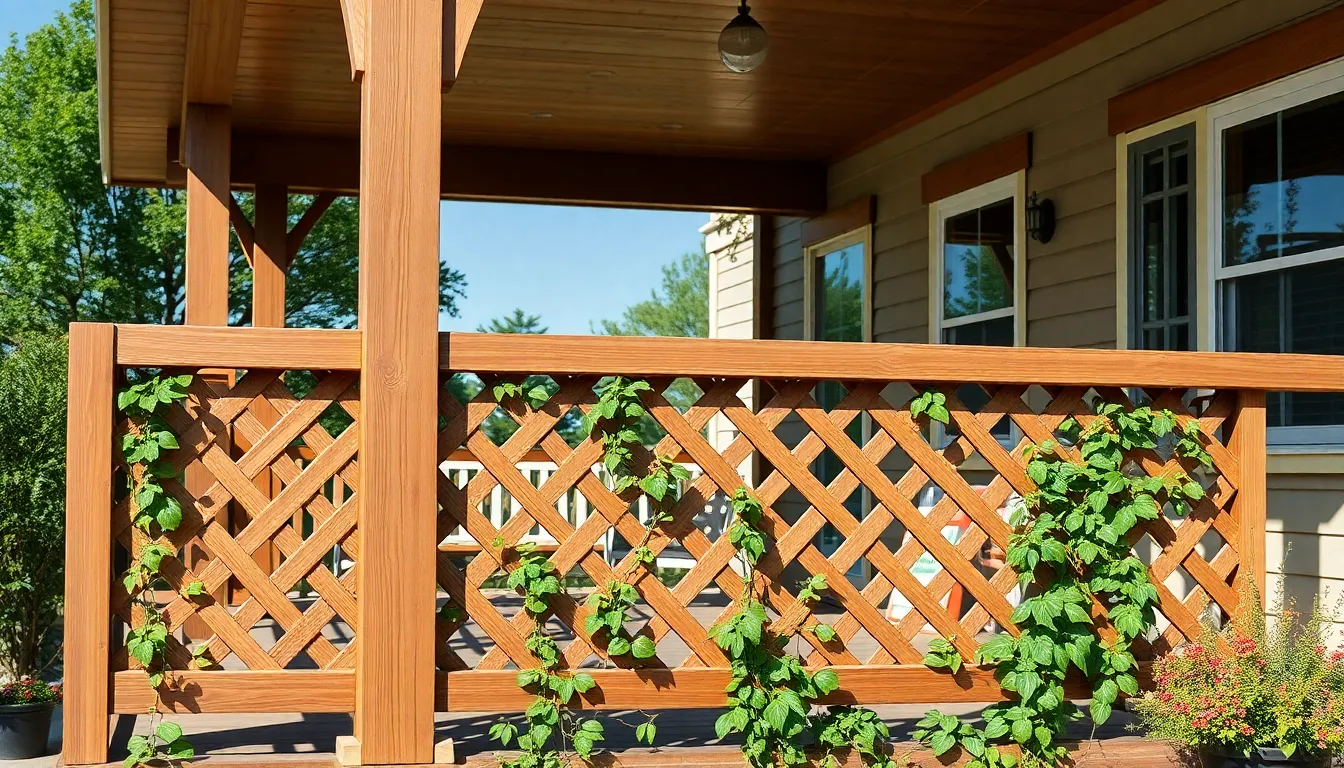
Wood lattice and trellis railings offer the perfect balance between decorative appeal and functional safety for porch designs. These versatile options create stunning geometric patterns while allowing natural light and airflow to pass through your outdoor space.
Diamond Pattern Lattice Screens
Diamond lattice screens represent one of the most timeless and elegant choices for wood porch railings. Arranged diagonally, wooden strips intersect to form beautiful diamond shapes that create visual interest without blocking natural light completely. Traditional designs feature this classic pattern because it adds sophistication while maintaining the semi-private barrier homeowners desire.
We love how diamond pattern lattice combines with vertical posts and rail caps to meet building safety requirements while improving curb appeal. Installation becomes straightforward when you work with pre-made lattice panels that fit between standard railing posts. Customization options include varying the diamond size to achieve different levels of privacy and visual density.
Square Grid Lattice Designs
Square grid lattice creates a more contemporary appearance through wooden strips that intersect at right angles to form perfect squares. Modern homeowners appreciate this clean-lined approach because it maintains the openness of traditional lattice while offering a geometric aesthetic. Building codes typically require openings small enough to prevent a 4-inch diameter sphere from passing through, which influences your spacing choices for these square patterns.
Versatility shines through when you adjust square sizes to achieve different visual effects throughout your porch design. Tight, small squares provide more privacy and create intricate shadow patterns, while larger openings deliver an airy feel that complements open porch layouts. We recommend alternating square sizes within the same railing system to add ever-changing visual texture.
Decorative Trellis Combinations
Decorative trellis railings elevate standard lattice panels by incorporating additional design elements like curved tops, integrated planters, or ornamental cutouts. These combinations transform your porch into an artistic focal point while serving as excellent support structures for climbing plants and vines. Strategic placement allows trellis panels to alternate with plain railings or integrate into partial knee walls for layered visual appeal.
Mixed material approaches enhance decorative trellis designs by combining wood lattice with metal balusters or glass panels for unique style blends. We’ve seen stunning results when homeowners incorporate boxed rail systems that feature trellis panels as decorative infill sections. Plant integration becomes a natural extension of trellis railings, creating living privacy screens that change with the seasons while adding natural beauty to your porch environment.
Cable and Wood Hybrid Railing Systems
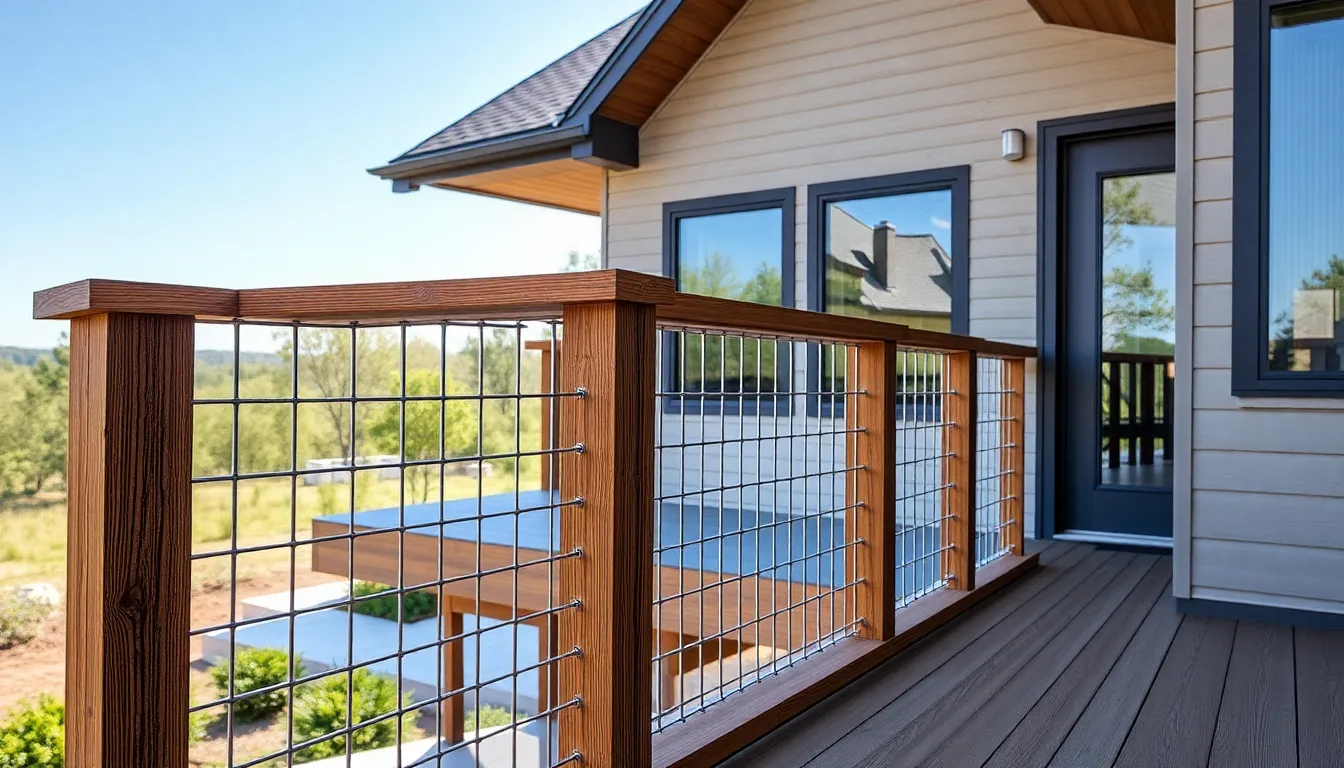
Cable railings combined with wood create a striking modern aesthetic that bridges traditional warmth with contemporary minimalism. These hybrid systems offer an innovative approach to porch design that maximizes views while maintaining essential safety features.
Wood Posts with Cable Infill
Wood posts serve as the backbone of cable infill systems, typically using 4×4 or larger dimensions for optimal stability and support. These sturdy supports frame thin stainless steel cable strands that thread through metal fittings or precision drilled holes. The design preserves the rustic charm of traditional wood construction while introducing sleek, low profile cable elements that function as modern balusters.
Staining or painting options allow wood posts to complement various architectural styles, from classic Craftsman designs to ultra modern aesthetics. We recommend selecting weather resistant wood species like cedar or pressure treated lumber to ensure long term durability. The cable threading process requires careful spacing to meet local building codes while maintaining the clean, unobstructed appearance that makes this system so appealing.
Modern Cable Rail Integration
Modern cable rail designs often eliminate bulky top rails entirely to maximize sightlines and create truly minimalist profiles. Some installations combine cables with glass panels or metal accents for eclectic, mixed material effects that push design boundaries. Short knee walls or solid wood bases paired with cables running above create sophisticated layered looks that work especially well on contemporary homes.
Adjustable tension systems built into modern designs maintain cable tautness and safety standards over time without compromising aesthetics. We’ve seen innovative installations that integrate lighting elements within the cable framework or use varied cable spacing to create visual rhythm. These systems work particularly well when the goal is preserving scenic views while meeting safety requirements.
Maintenance Benefits of Cable Systems
Cable railing systems paired with wood require significantly less maintenance than traditional wood baluster configurations. Stainless steel cables resist rust and weathering far better than metal balusters, maintaining their appearance and structural integrity through harsh weather conditions. The open design promotes airflow that minimizes moisture buildup, which can degrade wood components over time.
Periodic tension checks and occasional cleaning keep cable systems functional and looking new with minimal effort. Wood posts need standard care like sealing or staining every few years, but the cables themselves simplify long term upkeep dramatically. We find that homeowners spend roughly 60% less time on railing maintenance compared to traditional all wood systems, making this hybrid approach both beautiful and practical.
Curved and Arched Wood Railing Designs
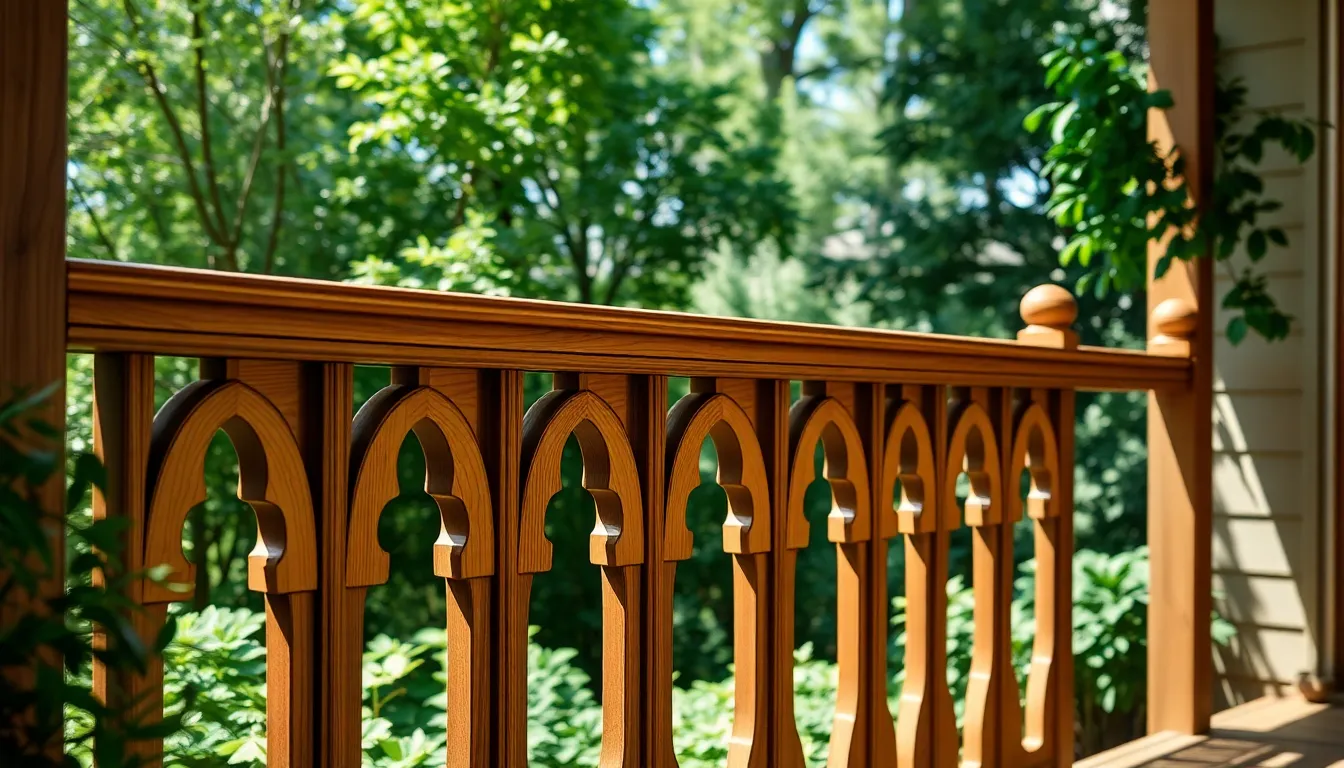
Moving beyond straight lines and geometric patterns, curved and arched wood railings introduce graceful movement and organic beauty to your porch design. These sophisticated elements soften harsh angles while maintaining structural integrity and safety compliance.
Elegant Curved Top Rails
Curved top rails transform ordinary porch railings into sophisticated architectural features that flow naturally with your outdoor space. We recommend designing these rails to follow the shape of your porch or deck, creating smooth sweeping curves that provide both visual appeal and ergonomic hand placement. Traditional homes benefit from gentle arcs that complement existing architectural details, while contemporary designs can incorporate more dramatic curves for bold statements.
Installing curved top rails requires skilled craftsmanship since each piece must be custom cut and shaped to achieve the desired flow. Professional woodworkers typically use steam bending techniques or laminated construction methods to create these elegant curves without compromising structural strength. The result delivers a refined edge that works beautifully in both Victorian and modern settings without overwhelming your porch’s overall design aesthetic.
Arched Cutout Patterns
Arched cutouts in wood railings create intricate patterns that add ornamental interest and vintage charm to any porch design. Victorian and Craftsman inspired railings frequently showcase these decorative elements, ranging from simple single arches to complex scroll saw patterns featuring triple circle arches or delicate leaf motifs. We’ve found that these cutouts work exceptionally well when combined with turned balusters, creating rich interplays of textures and forms.
Scroll saw work enables craftsmen to achieve precise arched patterns that maintain structural integrity while introducing ever-changing visual elements. Custom geometric patterns including chevron or chippendale inspired designs can bring unique artistic flair to your traditional arched railings. These decorative cutouts allow natural light to filter through while providing the safety barriers required by building codes.
Flowing Organic Shapes
Organic shapes in wood porch railings mimic natural curves found in waves, vines, and other flowing patterns that seem to grow along your railing system. Achieving these sophisticated designs typically requires intricate scroll saw work or custom craftsmanship that transforms standard lumber into artistic woodworking elements. We recommend incorporating these flowing lines to soften your porch’s appearance and create better integration with natural surroundings.
Custom artisans can create vine like patterns or wave inspired curves that introduce artistic elements while maintaining functional safety features. These organic designs work particularly well when combined with other materials such as glass or metal accents, further modernizing the appearance while preserving wood’s natural warmth. The flowing nature of these shapes creates visual movement that draws the eye along the length of your porch railing system.
Painted vs. Stained Wood Railing Options
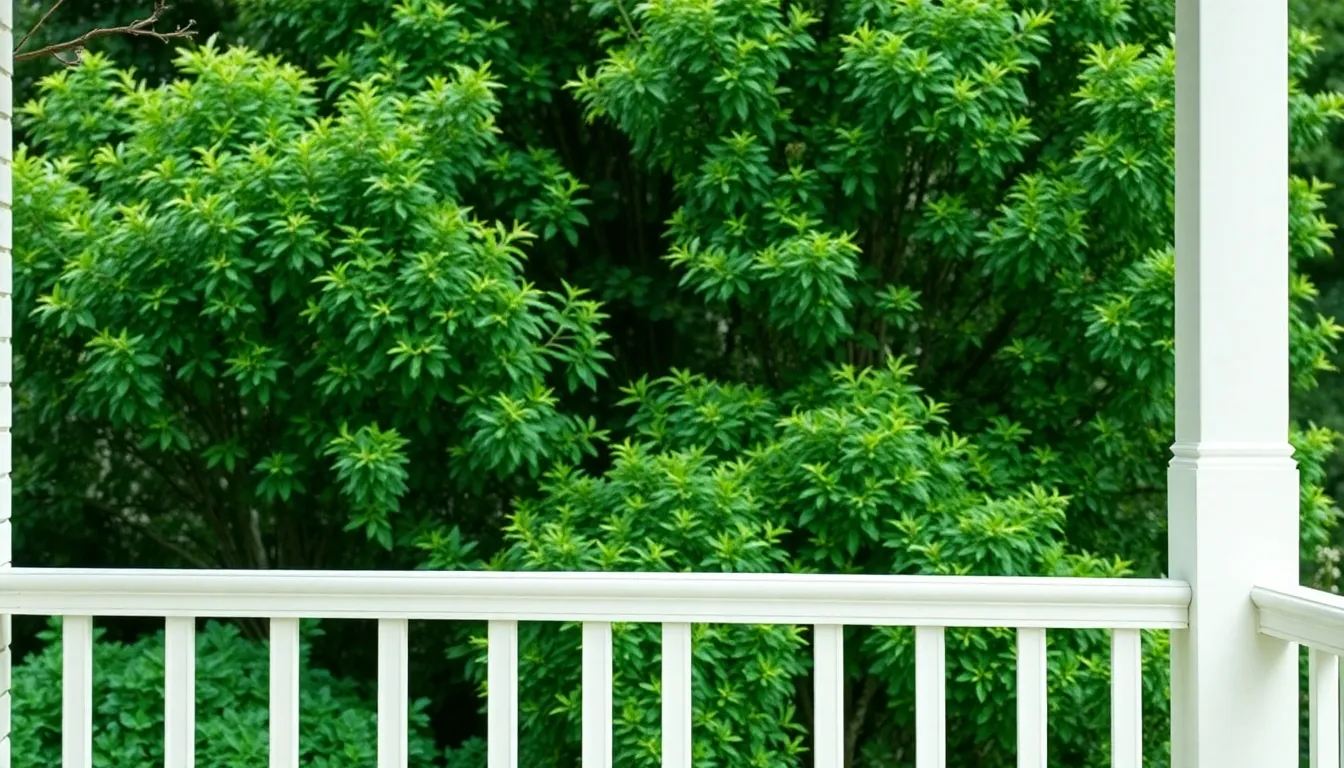
Choosing between painted and stained finishes represents one of the most important decisions we’ll make for our wood porch railings. Each approach offers distinct advantages that can dramatically transform both the appearance and maintenance requirements of our railing system.
Popular Paint Color Choices
Classic white and off white dominate the painted porch railing industry, delivering a clean and timeless appearance that complements nearly any home style. We find these neutral tones create visual cohesion with trim work while providing maximum versatility for future design changes.
Soft grays and beige tones are trending among homeowners seeking subtle modern appeal without overwhelming their exterior color palette. These earthy selections blend seamlessly with natural materials like stone and brick while maintaining contemporary sophistication.
Bold color statements using navy blue, forest green, or black create striking accent opportunities that work exceptionally well on craftsman style and contemporary porches. We’ve observed these dramatic choices particularly effective when they contrast with lighter siding or coordinate with existing architectural details like shutters and doors.
Natural Wood Stain Finishes
Light natural stains preserve the wood’s inherent grain patterns while adding subtle warmth that enhances the organic beauty of our railing materials. These finishes work particularly well with cedar and pine species that showcase attractive wood characteristics.
Medium to dark brown stains introduce richness and depth that ties beautifully into other wooden elements like decking, furniture, and pergola structures. We recommend these deeper tones for homeowners wanting to create cohesive outdoor living spaces with unified material palettes.
Transparent and semi transparent stains maintain visible wood texture while providing essential protection against weathering and UV damage. Many homeowners combine these lighter stains with additional sealant applications to improve long term durability and extend maintenance intervals.
Weather Protection Considerations
Paint creates a thicker protective barrier that prevents moisture penetration more effectively than stain, though it can crack or peel over time and require sanding before reapplication. We’ve found high quality exterior paints designed specifically for wood provide the most reliable long term protection.
Stains penetrate deep into wood fibers to protect from within, but they typically fade faster than paint, especially clear or light colored formulations exposed to intense sunlight. Weather resistant sealers applied over stain finishes can significantly extend their lifespan and reduce maintenance frequency.
Regular maintenance schedules prove essential for both painted and stained railings due to constant exposure to sun, rain, and temperature fluctuations throughout the seasons. Following proper application instructions for priming and sealing helps maximize protection and keeps our porch railings looking great for years to come.
Budget-Friendly DIY Wood Railing Projects
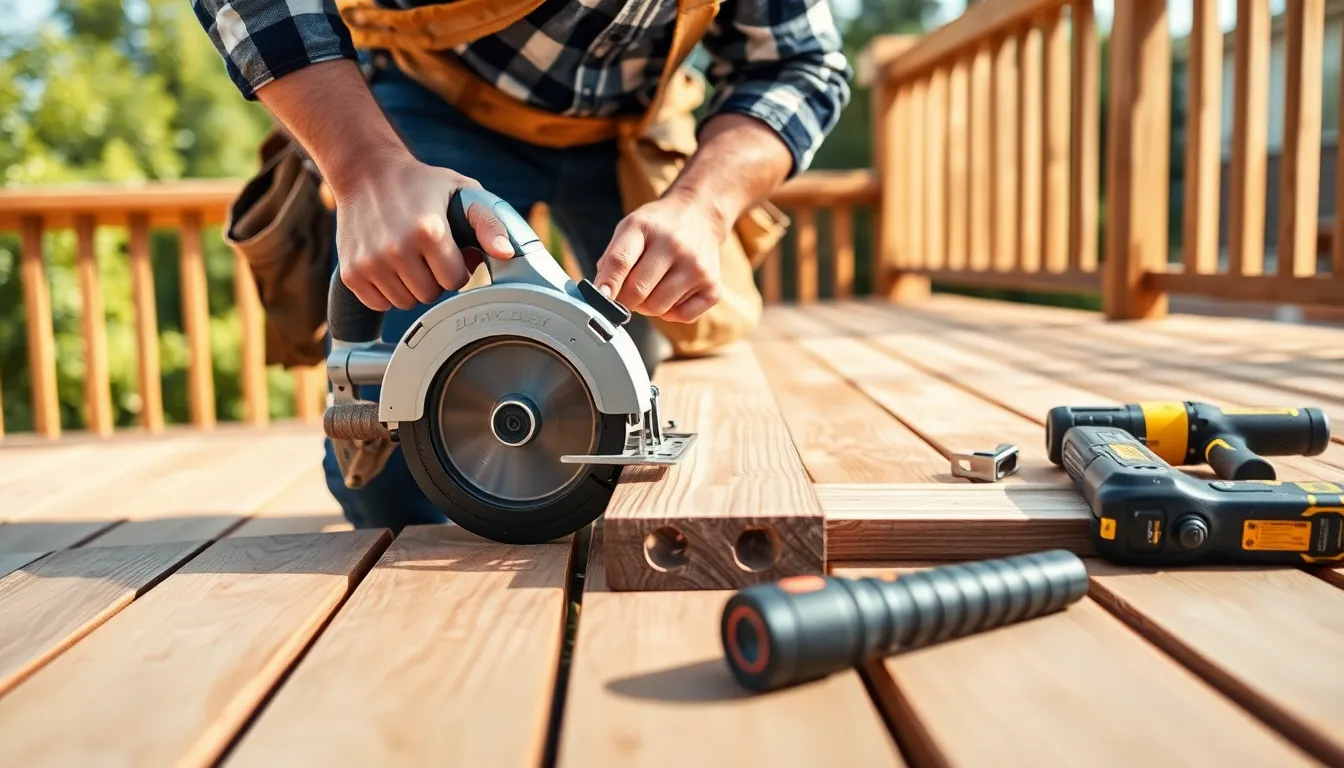
Building beautiful wood porch railings doesn’t require a massive budget or professional expertise. We can create stunning railings using affordable materials and simple techniques that deliver both safety and style.
Simple Construction Techniques
Start with a solid foundation by inspecting and reinforcing your deck frame’s ledger boards, joists, and blocking. A sturdy frame prevents wobbly railings and saves us from costly future repairs.
Secure 4×4 wood posts directly to your deck or concrete base using brackets and threaded rods as an affordable alternative to expensive post bases. This method maintains stability while cutting costs significantly.
Install horizontal top rails and bottom rails between the posts using basic fastening techniques. We recommend pre-drilling holes to prevent wood splitting and ensure clean connections.
Add vertical balusters using 2×2 or 2×4 stock spaced according to local building codes. Most areas require spacing where a 4 inch sphere can’t pass through the gaps.
Use essential tools like a circular saw or miter saw for cutting lumber to size, plus a power drill for fastening and a level for proper alignment. These basic tools handle most railing construction tasks effectively.
Cost-Effective Material Options
Pressure treated wood offers the most affordable option while providing excellent resistance to rot and insects. We find this material perfect for budget conscious projects that still need durability.
Cedar or redwood delivers natural beauty and moderate pricing for those wanting enhanced aesthetics. Both woods resist weathering naturally without requiring expensive treatments.
Reclaimed wood or pallet wood provides the lowest cost option, though it requires preparation time. We can transform these materials into unique railings with proper cleaning and refinishing.
Prefabricated balusters and railing kits reduce cutting waste and labor time while keeping costs manageable. Home improvement stores stock these components in various styles.
Basic wood posts and rails can be enhanced affordably by mixing in cable, glass, or metal accents. This approach creates modern looks without significantly increasing material costs.
Basic Tool Requirements
Circular saw or miter saw handles all wood cutting needs for standard railing construction. We prefer miter saws for their accuracy when making angled cuts.
Power drill with various drill bits manages all fastening requirements from pilot holes to final screw installation. Cordless models offer better mobility around the project area.
Level ensures straight and balanced rails throughout the installation process. We recommend a 24 inch level for most porch railing projects.
Carpenter’s square provides right angle accuracy when marking cuts and checking post alignment. This tool prevents measurement errors that could compromise the entire project.
Chalk line helps mark straight lines across longer sections of wood for consistent cuts. We use this tool especially when working with reclaimed materials.
Safety glasses and gloves protect us during all cutting and drilling operations. These essential safety items prevent injuries while handling lumber and power tools.
Premium Hardwood Railing Selections
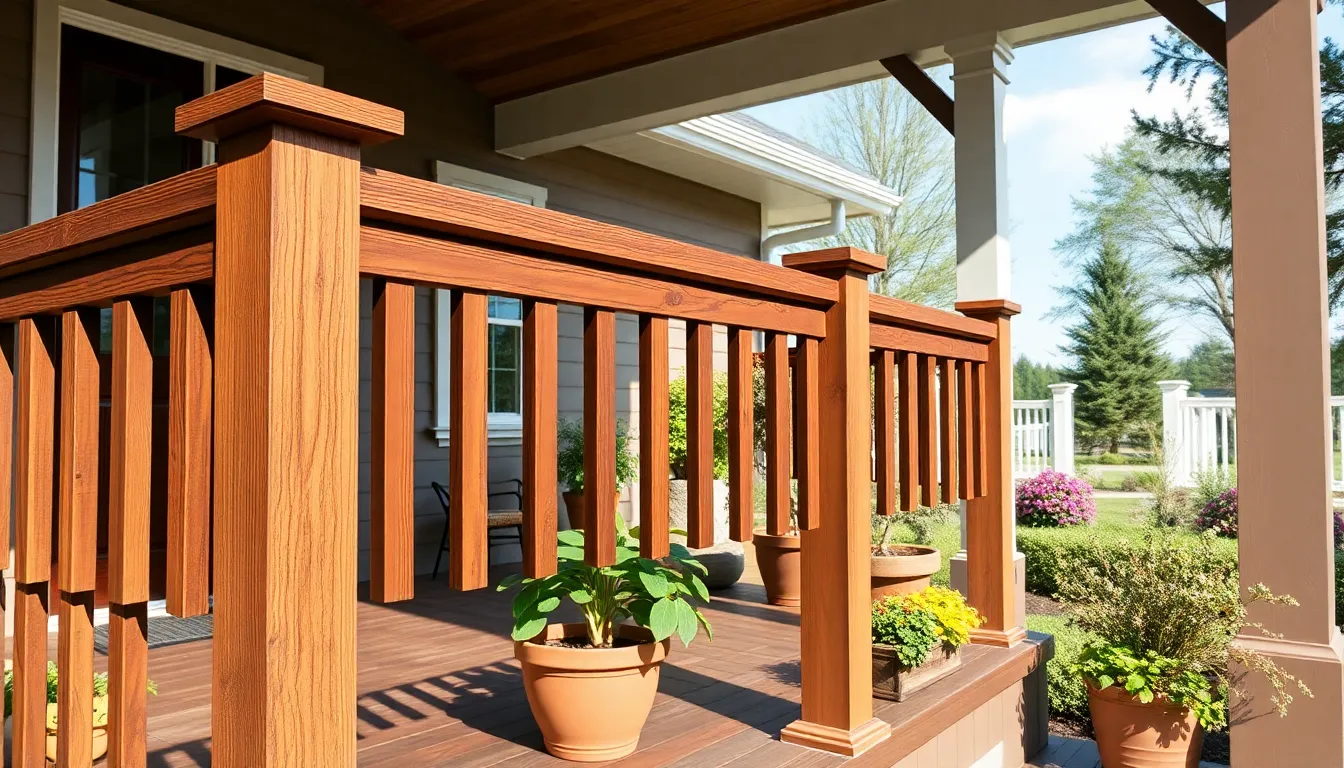
Premium hardwoods elevate porch railings beyond basic construction materials into sophisticated design elements. These superior materials offer unmatched beauty and performance that transforms ordinary porches into stunning outdoor spaces.
Exotic Wood Species Options
Exotic wood species bring remarkable character and exceptional durability to porch railing projects. Ipe stands out as one of the most sought after choices due to its incredible density and natural resistance to insects and moisture damage. Cumaru offers similar weather resistant properties while providing rich golden brown tones that deepen over time. Teak remains the gold standard for outdoor applications, delivering unparalleled longevity and distinctive grain patterns that create striking visual impact.
These premium species command higher prices than domestic options but deliver extraordinary performance in challenging outdoor environments. Density levels in exotic woods like ipe can reach up to three times that of traditional pine, creating railings that withstand decades of weather exposure without warping or deterioration. Color variations range from deep chocolate browns in cumaru to warm honey tones in teak, giving homeowners unique aesthetic options that can’t be replicated with standard lumber.
Durability and Longevity Benefits
Clear cedar leads the way in rot resistance among premium hardwood selections, featuring knot free grain and natural decay fighting properties. This superior lumber maintains structural integrity for decades when properly installed and maintained. Weather resistance becomes paramount in porch applications where railings face constant exposure to moisture, UV rays, and temperature fluctuations.
Premium hardwoods demonstrate exceptional performance against common outdoor threats like insect damage and moisture penetration. Protective finishes and sealants enhance these natural properties, creating barriers that extend service life even further. Maintenance requirements decrease significantly with quality hardwood selections, reducing long term ownership costs and preserving aesthetic appeal year after year.
Investment Value Considerations
High quality hardwood railings contribute measurable value to property assessments and buyer appeal. Real estate professionals consistently note that premium outdoor features like exotic wood railings set homes apart in competitive markets and justify higher asking prices. Curb appeal improvements from sophisticated railing materials often recoup initial investment costs through increased property values.
Long term financial benefits extend beyond resale considerations to include reduced replacement and repair expenses. Premium hardwoods typically last 15 to 25 years longer than standard materials, making the higher upfront costs economically sound over time. Luxury materials like teak and ipe position homes in premium market segments where discerning buyers expect quality craftsmanship and superior materials throughout the property.
Maintenance Tips for Wood Porch Railings

Proper maintenance keeps wood porch railings looking beautiful and functioning safely for years to come. Regular care routines prevent costly repairs and preserve the investment you’ve made in your home’s exterior design.
Seasonal Care Requirements
Spring and fall demand the most attention for wood railing maintenance as these seasons bring the greatest accumulation of debris and moisture. Clear all furniture and decorative items from the porch area to ensure complete access to every railing component during your inspection.
Remove spider webs, leaves, pollen, and dirt that collect between balusters and along horizontal surfaces during these peak seasons. This debris buildup can trap moisture against the wood and accelerate deterioration if left unchecked.
Inspect every section of your railings during each seasonal transition to identify loose nails, cracked wood, or signs of wear before they become safety hazards. Check all connection points where posts meet the deck structure and where balusters attach to top and bottom rails.
Look for early signs of rot or insect damage particularly around areas where water tends to collect or where the wood contacts other materials. Address these issues immediately to prevent them from spreading to healthy sections of your railing system.
Cleaning and Refinishing Guidelines
Mix warm water with mild detergent or use a specialized deck cleaner in a bucket to create an effective cleaning solution for your wood railings. Avoid harsh chemicals that can damage the wood fibers or strip protective finishes prematurely.
Scrub the railings gently using a soft or stiff bristled brush for 20 to 30 minutes to remove embedded dirt and mildew without gouging the wood surface. Pay special attention to areas where moisture tends to accumulate or where debris commonly collects.
Rinse thoroughly with clean water after scrubbing to remove all cleaning solution residue that could interfere with future finish applications. Allow the wood to dry completely before proceeding with any refinishing work.
Sand rough spots and splinters smooth before applying new finishes to ensure proper adhesion and a professional looking result. Use fine grit sandpaper to avoid creating deep scratches in the wood surface.
Apply high quality outdoor sealant or paint with UV protection to shield the wood from weathering and moisture damage. Choose products specifically formulated for exterior wood applications to maximize protection and longevity.
Clean your railings at least twice per year to maintain their appearance and structural integrity according to industry maintenance standards. This regular schedule prevents the accumulation of damaging elements and extends the life of your railing system.
Common Repair Answers
Tighten loose screws, nails, and bolts immediately when you discover them during your seasonal inspections to maintain railing stability and safety. Use appropriate fasteners for your exact wood type and connection method.
Replace damaged or rotten wood sections without delay to prevent structural compromise and maintain code compliance for your porch railing system. Match the wood species and dimensions of original components whenever possible.
Sand minor cracks and apply matching finish to prevent water infiltration that leads to more extensive deterioration. Small repairs performed promptly can prevent the need for major reconstruction projects later.
Check and adjust post stability by ensuring all anchor points remain secure to the deck structure and that posts haven’t shifted or loosened over time. Proper post alignment is crucial for the entire railing system’s structural integrity.
Conclusion
We’ve explored a wide range of wood porch railing options that can transform your outdoor space into something truly special. From classic spindle designs to modern cable hybrids each style offers unique benefits that can complement your home’s architecture while providing essential safety features.
The key to success lies in matching your railing choice to your lifestyle budget and maintenance preferences. Whether you opt for budget-friendly DIY answers or invest in premium hardwoods the right wood railing will enhance your home’s value and curb appeal for years to come.
Remember that proper installation and regular maintenance are crucial for maximizing your investment. By following the guidelines we’ve shared you’ll ensure your wood porch railings remain both beautiful and functional throughout their lifespan.
Frequently Asked Questions
What are the most popular wood railing styles for porches?
The most popular wood railing styles include classic turned spindle railings, horizontal wood slat designs, rustic log and branch railings, lattice and trellis patterns, and modern cable-wood hybrid systems. Traditional Victorian spindles with intricate lathe work remain timeless, while contemporary horizontal slats offer clean, modern lines. Each style complements different architectural aesthetics and budgets.
How do I choose between painted and stained wood railings?
Choose paint for maximum weather protection and color flexibility, especially with classic whites or trendy grays. Select stain to showcase natural wood grain while providing protection. Paint requires more frequent touch-ups but offers superior moisture resistance. Stain penetrates deeper and typically lasts longer but may need reapplication every 2-3 years depending on weather exposure.
What’s the most budget-friendly way to build wood porch railings?
Use pressure-treated lumber for posts and rails, which offers good durability at lower costs. Simple horizontal rail designs with basic 4×4 posts are most economical. Consider prefabricated components to reduce labor time and material waste. Enhance basic designs with affordable accents like cable or metal elements for a modern look without premium material costs.
Which wood species offer the best durability for porch railings?
Premium hardwoods like Ipe, Cumaru, and Teak offer exceptional durability and rot resistance, lasting 20+ years with minimal maintenance. For budget-conscious options, cedar and redwood provide natural weather resistance at moderate costs. Pressure-treated pine is the most economical choice, though it requires more frequent maintenance and refinishing to prevent deterioration.
How often should I maintain my wood porch railings?
Inspect railings twice yearly during spring and fall for loose fasteners, damage, or deterioration. Clean annually with gentle solutions to remove dirt and mildew. Refinish painted railings every 3-5 years and stained railings every 2-3 years, depending on weather exposure. Address minor repairs immediately to prevent costly structural damage and maintain safety.
Are cable and wood hybrid railings worth the investment?
Yes, cable-wood hybrid systems offer excellent value by maximizing views while maintaining safety. They require significantly less maintenance than traditional wood balusters and provide a sleek, modern aesthetic. Initial costs may be higher, but reduced upkeep and enhanced curb appeal make them cost-effective long-term investments for contemporary home designs.
What safety codes should I consider for DIY wood railing projects?
Ensure railings are 36-42 inches high for porches over 30 inches above ground. Balusters or infill spacing must not exceed 4 inches to prevent children from slipping through. Posts should be spaced no more than 8 feet apart for structural integrity. Always check local building codes before construction and consider professional consultation for complex designs.

